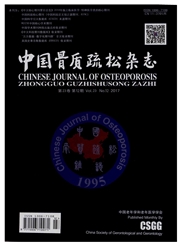

 中文摘要:
中文摘要:
目的探讨定量CT(QCT)测量膝关节骨密度(BMD)的重复性研究。方法选取北京积水潭医院确诊为一侧膝关节前交叉韧带损伤(未经治疗),另一侧膝关节健康的30名患者行双膝关节QCT骨密度检测,2名观察者用定量CT的测量技术前后两次独立测量患者双膝关节股骨远端内外侧髁及胫骨平台处骨密度。结果双因素方差分析,除双膝关节胫骨平台内上1/9处BMD值统计学有差异(P〈0.05,ICC〉0.7),同一观察者不同时间测量同一部位的BMD值均值相近,无统计学差异(P〉0.05,ICC〉0.9)。不同观察者所测定的BMD值也无显著性差别(P〉0.05,ICC〉0.9)。结论定量CT能够测量膝关节松质骨的体积骨密度,并且重复性良好,可用于评价膝关节骨密度的状态及应用于临床。
 英文摘要:
英文摘要:
Objective To evaluate the reproducibility of the knee bone mineral density (BMD) measurement by quantitative CT(QCT). Methods The knee BMD was measured by QCT in 30 subjects with unilateral anterior cruciate ligament(ACL) injury. Using QCT, two observers measured the BMD of medial and lateral condyle of distal femur and tibial plateau of both knees, respectively. Results There was no statistically significant differences between the results of the two observers ( P 〉 0. 05, ICC 〉 0. 9 ) or between the results of the two different times ( P 〉 0.05, ICC 〉 0. 9) through two-way analysis of variance, except the BMD of 1/9 section of tibial plateau (P 〈 0. 05, ICC 〉 0.7 ). Conclusion QCT can be used to measure the knee bone mineral density with high reproducibility.
 同期刊论文项目
同期刊论文项目
 同项目期刊论文
同项目期刊论文
 期刊信息
期刊信息
